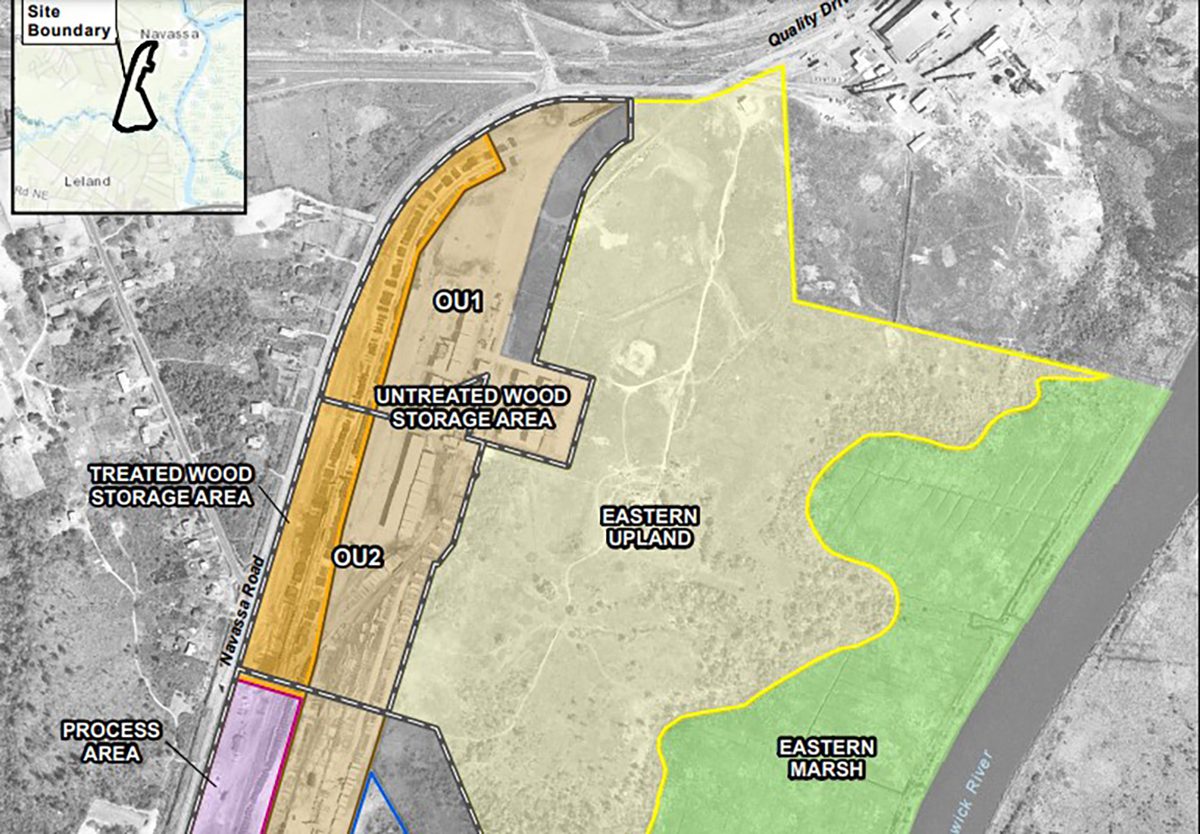
The only viable offer last year to buy land formerly tied to the Kerr-McGee Chemical Corp Navassa Superfund Site came with a proposal to use the property for warehousing.
That is not what residents of the Brunswick County town wanted then. By all accounts, it’s not what they want now.
Supporter Spotlight
The question “what now” lingers nearly a year after the bidding invitation closed to prospective buyers for 87 acres once part of the 200-acre former wood treatment site.
Right now, there’s no hurry to sell, Claire Woods, Greenfield Environmental Trust Group director of environmental justice policies and programs, assured residents during a meeting Tuesday night.
“We haven’t heard anyone support the warehousing proposal,” Woods said. “We really want to listen to the community here and we’re not in a rush to sell the property.”
Residents overwhelmingly support a mixed-use type of planned development, one that would include a town center-like commercial area where townsfolk could shop for groceries, gas up their vehicles, and gather with family and friends for meals in restaurants.
After the bidding period closed last November, Woods said the group spent time trying to understand the reasons why the property received so little response.
Supporter Spotlight
“It’s such a beautiful property,” she said. “There’s a lot of opportunity and we thought that there would be more viable bids coming in than we had.”
A broker they hired to give them some understanding of what the path forward might be told them the current market only supports light industrial uses for the property.
That leaves the town with two options.
The property could be subdivided into tracts where buyers could put light industrial uses such as warehousing on it, which might allow for some tax base, maybe even jobs. But residents have said that existing warehousing in the town doesn’t really provide much of a tax base or jobs, according to Woods.
“Or, we can wait until the market potentially supports a different use in the future and a use that’s more consistent and compatible with what we understand community members here want,” she said.
Navassa anticipates growing exponentially as new, large housing developments crop up in the town, which sits across the Cape Fear River from downtown Wilmington.
The town is set to receive about a 30-acre donation for land that will include a heritage center, walking trails and other ecotourism-related amenities.
Navassa Councilwoman Ida Dixon said Tuesday night that she can’t imagine a warehouse sitting near the heritage center.
“For me, and the citizens I’ve spoken with, they don’t want to see warehouses popping up in that area. Like we say, we waited this long. I grew up playing in that area as a child. My father worked in that area. For me, I’d rather wait until the citizens can get what they want. Speaking for the citizens that I’ve spoken to they want to see some type of businesses going in there,” she said.
Woods said that Dixon’s remarks “are very similar to almost everyone we’ve talked to.”
“We have had comments that state that they want us to move forward with the development of it now, but not warehousing,” Woods said.
The former Kerr-McGee site was added to the National Priorities List of federal Superfund sites in 2010 after creosote contamination was discovered in the groundwater, soil and sediment within portions of the property. Creosote is a gummy, tar-like substance used to treat wood, including railroad ties and electric utility poles.
The U.S. Environmental protection Agency divided the site into operable unit to distinguish geographic areas within the property, the level of contamination within those areas, and to determine the best course of action in remediating and cleaning those areas.
In an update on work being conducted in operable unit 2, EPA Remedial Project Manager Erik Spalvins said Tuesday night that creosote-contaminated soil from about 4 of the 16 acres within that unit is being excavated and moved to another unit, where it will be stockpiled.
Officials originally expected to excavate roughly 2 acres from OU2, an area used to store treated and untreated wood, and move the material to OU4.
“What is stockpiled as of today is about 4,000 cubic yards,” Spalvins said.
A majority of the material that is being stockpiled will be sealed off and remain in OU4. Excavated soil that contains higher levels of contamination will be removed from the site.
The EPA removed OU1 from the National Priorities List after that more-than-20-acre unit was deemed free from contamination and suitable for residential use.
Operable units 3, 4 and 5 are under various stages of investigation.







